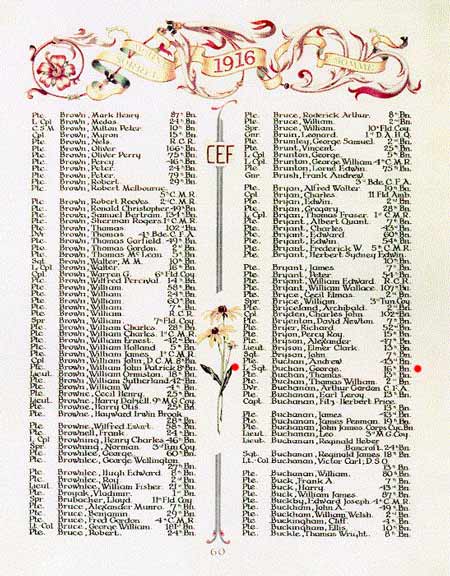The Canadian Book of Remembrance
1916

The 16th
Battalion (The Canadian Scottish) CEF was formed from four companies
of unrelated Highland regiments. On the sea voyage to England, the
Regiment was still dressed in four different styles, tartans and badges.
The first Canadian Contingent
sailed for England on 3 October 1914. The 16th Battalion was part
of the 3rd Infantry Brigade, 1st Canadian Division. Its motto Deas
Gu Cath was adopted on the third day of the voyage. It was on 16 December,
on Salisbury Plain, that the battalion was sub-titled 'The Canadian
Scottish'. It sailed for France on 12 February 1915 and disembarked
at St. Nazaire three days later. Between 17 February and 2 March each
Canadian brigade was attached to a British division in front of Armentières
for indoctrination in trench warfare.
French defensive policy,
in the event of an enemy attack, was for the front line troops to
fall back and let the artillery deal with the attackers; British policy,
as reflected in Canadian orders, was to hold the trenches at all costs.
Thus the Canadians first task was to develop their forward defences.
At 1600 hours on 22 April 1915 French colonial troops on their left
came under heavy bombardment followed, an hour later, by the first
gas attack in the history of warfare. The line broke, exposing the
Canadian flank and opening the way to Ypres. That night the 3rd Brigade
partly restored the situation by counter-attacking with the 10th and
16th Battalions, though much further fighting - including a second
attack with gas, lay ahead. To commemorate the first night's counter-attack
at Kitcheners Wood, the Militia units perpetuating the 10th and 16th
Battalions ( 10th : The Calgary Highlanders. - 16th : The Canadian
Scottish Regiment (Princess Mary's) based in Victoria, BC ) wear on
their shoulder epaulettes an emblem of an acorn and an oak leaf.
The war cost the 16th
Battalion 5491 casualties, of which 1412 were fatal. Honours and awards
included four Victoria Crosses. Other awards included 9 DSOs, 40 MCs,
30 DCMs and 204 MMs, plus French, Belgian, Russian, Serbian, Montenegrin
and Italian medals (Canadian Scottish specialists were posted to assist
Allied armies).